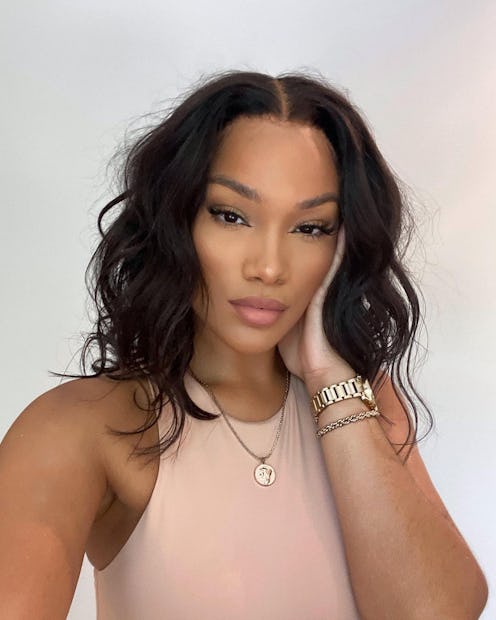(Hair)
Sew-In Weaves Make A Triumphant Return & They’re Better Than Ever
Simply flawless.

Hair trends come and go in a flash. It’s not uncommon for a style to be red-hot one minute, disappear for awhile, then reemerge all over again. However, when they do, the original has likely been remixed before blowing up on social media. But the latest viral look, traditional sew-in hair extensions, is a complete throwback. For many Black women, the resurgence of this classic weave style comes with little surprise. While lace front wigs offer a quick solution for trying fun hair colors or cuts, they aren’t always ideal for long-term wear. Sew-ins, however, are designed to withstand washes, hot tools, and styling.
To be fair, your lifestyle and daily activities are always major factors when choosing a new hairstyle. But as celebrity hairstylist Alexander Armand tells TZR, the slightest bit of sweat or oil around the lace hairline can cause a wig to lift or move out of place. “With a sew-in, you have a lot more flexibility and longevity — which is something you want with a protective style,” he says. The comeback of traditional weaves is in line the beauty industry’s current shift to more natural looks.
Ahead, TZR spoke with three celebrity hairstylists for a complete breakdown of traditional sew-ins, including what to know beforehand and tips for achieving a long-lasting style.
What Is A Sew-In Weave?
As the name implies, a sew-in weave is a method of installing extensions using a needle and specialty thread. The wearer’s natural hair is braided into a unique pattern and wefts of hair are sewn into the braids to attach it all together. This traditional technique often leaves some natural hair loose around the perimeter of the head, untucked from the braids, to give the most realistic look and feel possible.
What Are The Benefits Of A Sew-In weave?
Along with a natural look, sew-ins have a slew of other benefits. Requiring little upkeep after the initial installation, they’re low-maintenance and are an effective protective style. Like any type of braid, a sew-in keeps your own hair tucked away and shielded from heat and chemicals like color treatments, hot tools, or relaxers. “The traditional method is favored because it maintains the health of your natural hair and gives you a versatile hairstyle,” says Takisha Sturdivant-Drew, celebrity hairstylist and founder of TSD Hair Extensions. As such, the braids are great for those trying to grow their strands out a few more inches. But perhaps the most notable benefit of a sew-in is its longevity. According to Kenna Edgehill, hairstylist and expert at Unice, your weave can last up to two months with proper care.
What To Know Before Your Appointment
If you’re new to weaves, you’ll want to find a stylist versed in extensions and the sew-in technique. A consultation discussing your hair type and goals will help determine key factors such as the braid pattern and the amount of bundles needed. Like any braided style, there’s a risk of tension with a sew-in. If you have a finer texture, this may not be the best protective hairstyle, as it can add stress to the hair.
Your stylist can also help you determine the amount of hair bundles you’ll need for your desired style. For a traditional sew-in, Armand tells TZR that two bundles of hair are enough to cover the head, but if you want an extra-full look, you can opt for three instead. Length also plays a key factor, as longer extensions typically have shorter wefts. Edgehill explains that styles 26 inches or longer will likely need three to five bundles to achieve fullness.
How To Get A Seamless Look
If you’re of a certain age, you probably recall that the sew-ins of yesteryear could have a bulky appearance depending on the braids underneath. However, today’s styles offer the flat look for which wigs are so beloved. “Getting a seamless look is all about the braid down,” says Armand. Similarly, Edgehill explains that creating a pattern from thin braids that follows the circumference of the head will help your style have a smooth appearance.
Applying the wefts in a precise manner also contributes to a sleek finish. All three stylists note that using double wefts, stacking, or the flip-over method can lead to an unwanted hump and boxy appearance. Instead, ensure your stylist is installing hand-cut pieces of the wefts from temple to temple.
How To Maintain A Sew-In
If you’re new to sew-ins, managing your natural hair beneath can be a little tricky. Adjusting your routine to include braid-friendly products will help. “With a sew-in, you won’t have direct access to your scalp, but you still need to cleanse and hydrate your scalp,” says Armand. The pro notes that using a nutrient-rich oil with a nozzle or an eye dropper, like this one by Florish, will ensure your hair stays moisturized for the duration of your style.
Cleaning the weave properly is also important. “Shampooing between appointments will help reduce buildup and itchiness,” Edgehill advises. Look for a formula rich in vitamins, like TSD Hair’s Provitamin Shampoo that will nourish the extensions and your hair beneath. However, you need to ensure the weave and natural hair are thoroughly dry before styling. In that vein, Armand recommends using a hooded dryer to dry the braids completely. “Maintaining the integrity of your hair underneath is the most important role of a protective style,” he says.
Not only will your natural hair thrive, but it will keep your sew-in looking fresh.